Question
Who likes grey
color? Answer the given questions based on the information given below. Sixteen persons are sitting around the two square tables. One square table is inscribed in another. Two persons sit on each side of the table. The persons on the inner table have different number of balls while the persons on outer table like different colours. J, K, L, M, N, O, P and Q sit on one table while A, B, C, D, E, F, G and H sit on another table. Each of the persons on both tables is facing the closest person opposite to them on different tables such that the persons on inner table are facing outwards while persons on outer table are facing inwards. Persons on inner table have different number of balls from 1 to 8. Also, persons on outer table like different colours among, red, black, pink, yellow, white, grey, blue and green. Note: If A is facing B then both are sitting opposite to each other on the different tables but on the nearest seat. J sits opposite to one, who sits to the immediate left of L, who has 3 balls. Both J and L are sitting on the opposite sides of the same table. The persons facing L is three places away from D. Q has twice number of balls of M, who has 3 balls more than K. K faces E, who likes yellow color. O sits to the immediate right of P, who has 7 balls, on the same side. A, who likes white color, faces O, who has 6 balls. E does not sit adjacent to A or C and K is not adjacent to L. C, who likes green color, sits second to the right of A. G sits to the immediate right of F, who likes red color and both sit on the same side. P has 2 more balls than N, who does not face G. The one, who has 4 balls, faces B, who likes Pink. M is not adjacent to J, who is not to the immediate right of N. G does not like Grey or Blue color.Solution
J sits opposite to one, who sits immediate left of L, who has 3 balls. Also, both sit on same table. The persons facing L is three places away from D. Q has twice number of balls than that of M, who has 3 balls than K. So, K, M and Q have 1, 4 and 8 balls respectively. K faces E, who likes yellow color. O sits immediate right of P, who has 7 balls, on the same side. A, who likes white color, faces O, who has 6 balls. C, who likes green color, sits second to the right of A. G sits to the immediate right of F, who likes red color and both sit on the same side. So, we have four cases, Case-1a 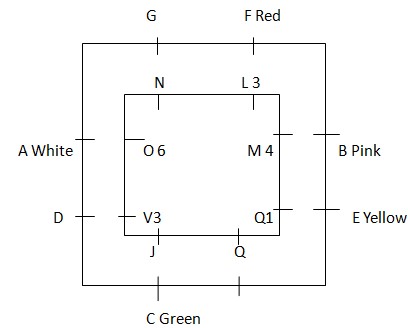 Case-1b
Case-1b 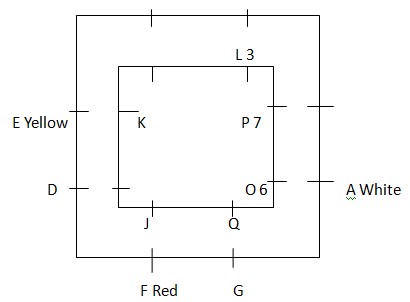 Case-2a
Case-2a 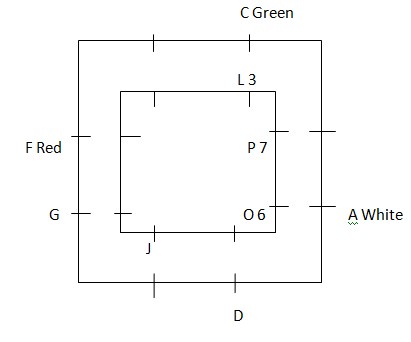 Case-2b
Case-2b 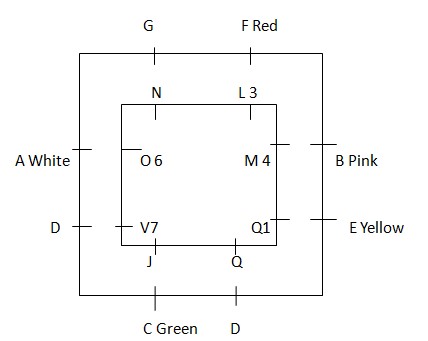 E does not sit adjacent to A or C and K is not adjacent to L. So, case 2(a) is rejected. P has 2 more balls than N, who does not face G. So, case 1(a) and 2(b) are rejected. The one, who has 4 balls, faces B, who likes Pink. M is not adjacent to J, who is not immediate right of N. G does not like Grey or Blue color. So, we have, Case-1b
E does not sit adjacent to A or C and K is not adjacent to L. So, case 2(a) is rejected. P has 2 more balls than N, who does not face G. So, case 1(a) and 2(b) are rejected. The one, who has 4 balls, faces B, who likes Pink. M is not adjacent to J, who is not immediate right of N. G does not like Grey or Blue color. So, we have, Case-1b 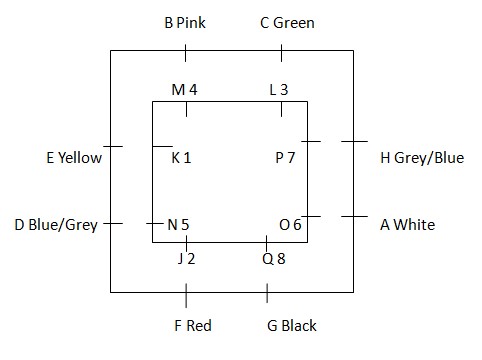
If the curved surface area and the radius of a cylinder are 550 cm2 and 7 cm, respectively, then find the volume (in cm3) of the c...
Two paths of width 6 metres are to be made in the centre of rectangular field such that they are perpendicular to each other. Find the area (in m2<...
The lengths of a pair of parallel sides of a trapezium are respectively 22 cm and 18 cm, and the perpendicular distance between these two sides is 15 cm...
A giant circular wheel has a diameter of 14 metres. In how many revolutions will the wheel cover a total of 16.5 km?
ABCD is a cyclic quadrilateral, such that ratio of measures ∠A, ∠B and ∠C is 1 : 4 : 5, then the measure of ∠D is.
- A right-angled triangle has its smallest median measuring 4.8 cm. Find the hypotenuse.
A race track is in the shape of a rectangle with length of 75 metres and area of 3000 m2. A car takes 20 seconds to make one lap around the p...
The lateral surface area of a cube is 196 cm2 . The length of a cuboid is 50% more than the side of the cube. The breadth of the cuboid is 3 ...
The area of four walls of a room is 144 cm2. If the length and breadth of the room were equal and the height of the room is 4 cm, then what i...
What is the measure of the radius of the circle that forms a triangle whose sides are 8 units, 15 units, and 17 units?
Relevant for Exams:



